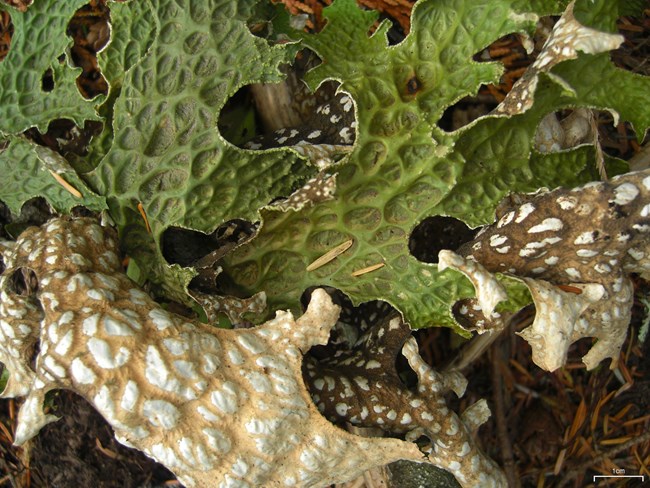Last updated: May 15, 2025
Article
Tree Lungwort

© Jason Hollinger
General Description
We all have favorite charismatic megafauna, but what about enigmatic microflora—do you have a favorite? Lobaria pulmonaria is in a group of enigmatic microflora called cyanolichens. These lichenized-fungi have cyanobacteria either as the sole photosynthetic partner in the lichen or as an additional partner with green algae. Scientifically, tree lungwort is grouped with other lichens in the Fungi kingdom, so it is named after the fungal partner; however, all lichens are more like small ecosystems than single organisms. Think of them as 'super-organisms' that grow in a stunning variety of shapes, sizes, and colors with a multitude of parts and functions.
Habitat and Distribution
A member of the family Lobariaceae, tree lungwort has worldwide distribution, thriving best in moist climates. The Pacific Northwest is home to six Lobaria species, of which L. pulmonaria is the most widespread. In the eastern Cascades it is more likely to thrive in old-growth forests; look for it in sheltered narrow valleys and riparian zones. In the western Cascades you may find it on young and old hardwood trees, less often on conifers. In any of these places, it may grow on tree trunks, in humid tree canopies, on shrubs, and despite its name, on mossy rocks, attached by fuzzy root-like structures growing from its lower surface.
Identification
The fungus, green algae, and cyanobacteria in tree lungwort are in distinct layers or small structures throughout the body, or thallus, of the lichen. The thallus is leafy with roughened ridges and smooth depressions on its upper surface. The algae live in a layer near the upper surface surrounded by fungal tissue, and the cyanobacteria live in the lower layers in small, internal, gall-like structures called cephalodia. Its underside is tan and covered with fine, short, velvety hairs. The thallus changes color in relation to sun exposure and moisture status: bright green when saturated, tan, brown or gray when dry.
Reproduction
Reproduction is mostly asexual via diaspores, tiny vegetative propagules (clones) containing both algal and fungal cells, or by fragmentation of the thallus. Dispersal mechanisms vary, including by wind, rain, and animals. Sexual reproduction is via fungal spores coming from reddish-brown disc shaped structures sometimes seen on the upper surface of the thallus. Once established on a substrate, growth is slow.
Ecology
Tree lungwort, with its cyanobacteria, absorbs nitrogen from the atmosphere and turns it into forms that it and other plants and animals can use. Nitrogen absorption is moisture and pH dependent, making lungwort a good air quality indicator, and important to nutrient cycles in forested ecosystems.
Fun Facts
-
The 'doctrine of signatures,' a pseudoscientific concept dating to the 1500s, states that a plant may have curative powers based on its similarity to human body parts, organs or fluids. Tree lungwort gets part of its common name from its superficial resemblance to lung tissue.
-
Linnaeus classified lichens as lower plants, dubbing them the 'rustici pauperrimi' (poor trash) of vegetation.
-
In Switzerland, tree lungwort is a protected species. A major corporation is applying for a collecting permit to harvest it for a cough syrup recipe.
Conservation
In young forests, maintain a mix of species and ages, including mature trees, and maintain nearby old-growth forests. Tree lungwort thrives best in older stands that are shady and cool. These areas are beautiful and majestic forests, worthy of protection in their own right.
Where to see
In the Klamath Network, Lobaria pulmonaria occurs at Crater Lake NP, Redwood NSP, and Oregon Caves NMP, but has no documentation at Lassen Volcanic NP or Whiskeytown NRA. Lobaria lichens are unlikely to grow at Lava Beds NM.
More Information
McCune, B. and L. Geiser. 2009. Macrolichens of the Pacific Northwest. 2nd ed. Oregon State University Press, Corvallis, OR.
https://www.waysofenlichenment.net/essays/readings_2_nameless.pdf
https://www.waldwissen.net/wald/naturschutz/arten/wsl_lungenflechte/index_EN
Download a pdf of this article.
Prepared by Kasey Rolih
NPS Klamath Inventory & Monitoring Network
Southern Oregon University
1250 Siskiyou Blvd
Ashland, OR 97520
Featured Creature Edition: September 2018
